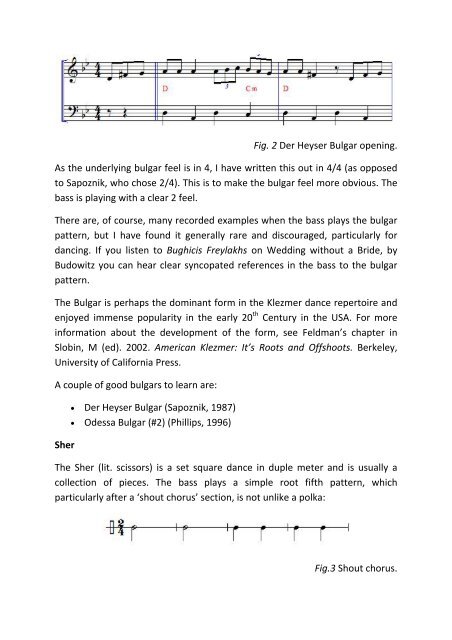Klezmer Bass: An Overview - Paul Tkachenko
Klezmer Bass: An Overview - Paul Tkachenko
Klezmer Bass: An Overview - Paul Tkachenko
Create successful ePaper yourself
Turn your PDF publications into a flip-book with our unique Google optimized e-Paper software.
Fig. 2 Der Heyser Bulgar opening.<br />
As the underlying bulgar feel is in 4, I have written this out in 4/4 (as opposed<br />
to Sapoznik, who chose 2/4). This is to make the bulgar feel more obvious. The<br />
bass is playing with a clear 2 feel.<br />
There are, of course, many recorded examples when the bass plays the bulgar<br />
pattern, but I have found it generally rare and discouraged, particularly for<br />
dancing. If you listen to Bughicis Freylakhs on Wedding without a Bride, by<br />
Budowitz you can hear clear syncopated references in the bass to the bulgar<br />
pattern.<br />
The Bulgar is perhaps the dominant form in the <strong>Klezmer</strong> dance repertoire and<br />
enjoyed immense popularity in the early 20 th Century in the USA. For more<br />
information about the development of the form, see Feldman’s chapter in<br />
Slobin, M (ed). 2002. American <strong>Klezmer</strong>: It’s Roots and Offshoots. Berkeley,<br />
University of California Press.<br />
A couple of good bulgars to learn are:<br />
Sher<br />
• Der Heyser Bulgar (Sapoznik, 1987)<br />
• Odessa Bulgar (#2) (Phillips, 1996)<br />
The Sher (lit. scissors) is a set square dance in duple meter and is usually a<br />
collection of pieces. The bass plays a simple root fifth pattern, which<br />
particularly after a ‘shout chorus’ section, is not unlike a polka:<br />
Fig.3 Shout chorus.


